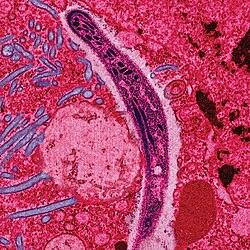| Parasitic disease | |
|---|---|
| Other names | parasitosis, parasitic infection |
 | |
| False-color electron micrograph of a Plasmodium sporozoite | |
| Specialty | Infectious disease |
A parasitic disease, also known as parasitosis, is an infectious disease caused by parasites. [1] Parasites are organisms which derive sustenance from its host while causing it harm. [2] The study of parasites and parasitic diseases is known as parasitology. [3] Medical parasitology is concerned with three major groups of parasites: parasitic protozoa, helminths, and parasitic arthropods. [2] Parasitic diseases are thus considered those diseases that are caused by pathogens belonging taxonomically to either the animal kingdom, or the protozoan kingdom. [4]